Astudillo, Palencia
Astudillo is a Spanish municipality in the autonomous community of Castilla y León belonging to the province of Palencia. It is located 29 km (18 mi) northeast of the provincial capital, and has 1,106 inhabitants (2011) with an area of 122.95 km2 (47.47 sq mi).
Astudillo
(Statilium, Stutilium, Studellum) | |
|---|---|
Municipality | |
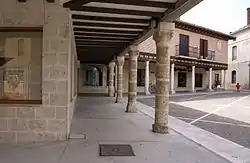 | |
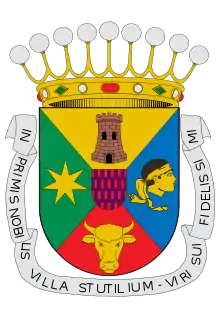 Seal | |
| Motto: In primis nobilis Villa Stutilium – Viri sui fidelissimi | |
| Country | Spain |
| Autonomous communities of Spain | Castile and León |
| Province | Palencia |
| Comarca | El Cerrato, Tierra de Campos |
| Government | |
| • Mayor | Luis Santos González (PP) |
| Area | |
| • Total | 122.95 km2 (47.47 sq mi) |
| Elevation | 780 m (2,560 ft) |
| Population (2018)[1] | |
| • Total | 1,004 |
| Postal code | 34450 |
| Area code | 979 822 |
| Website | Astudillo Town Council |
Toponym
The name Astudillo comes from Roman times, specifically from Tito Estatilio Tauro (Titus Statilius Taurus), the Roman general whose legions had their field operations in this Vaccaei region around the year 29 BC.[2]

According to historical records, the name evolved from Ancient Latin in the times of Augustus to modern Castilian: Statilium, Stutilium, Stitellum, Stutellium, Stutiellum, Stutiello, Studellum, Astutello, Astodello, Estodello, Estudillo, Astudil and Astudillo.[3][4][5][6]
STUTILIUM can be found in the motto of the official Coat of Arms of the municipality of Astudillo.[7]

History

Astudillo has ancient origins, Roman remains having been found within its surroundings. In the Middle and modern ages it was involved in textile production. It was declared a Historic-Artistic Site in 1995. In the municipality there are several churches, the Castle of La Mota[8][9] and the Convent of Santa Clara. The origins of Astudillo are prehistoric, having been located within its area several settlements from the Bronze Age and Iron Age. Astudillo and the region were already occupied in Roman times.[10]
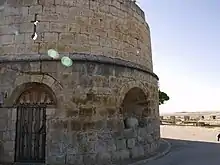
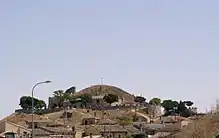
In the 11th century, Astudillo was already head of Alfoz, so the town was a walled place from early medieval times, you can still see one of the six gates it had, the gate of San Martin, of the others only remains their memory and their names: Revilla, Santa Eugenia, San Pedro, Santa Clara and Santoyo.[11] In the middle of the twelfth century, King Alfonso VII, granted privileges to the knights of Astudillo consisting in a wide range of exemptions and freedoms.[12][13]
In the thirteenth century, King Ferdinand III of León & Castile, ratified the charter of the town and extended with rights of merchandise, making it an important stronghold.
Throughout history several queens boasted the lordship of the town. In the twelfth century, it was Eleanor of England, Queen of Castile, wife of Alfonso VIII of Castile. During the thirteenth century, it was the lordship of his daughter Berenguela, and later of Violant of Aragon, wife of Alfonso X the Wise . In the 14th century, it was the lordship of María de Molina, who stifled the attempt to occupy the village by the rebel Juan Núñez de Lara. King Peter of Castile and his lover, María de Padilla, who seems to have been born in the town, made Astudillo their habitual residence, having there the king's palace and the queen without a crown. In 1353, Maria de Padilla founded the Convent of Santa Clara, which can still be admired today. Beatrice, daughter of María de Padilla and the king, was the lady of the town. Juan II of Castile established his chancellery in Astudillo. Later the town passesd to the lordship of Ruy Díaz de Mendoza whose heirs would be counts of Castrojeriz. In 1520, the town of Astudillo adheres to the communal uprising, joining the Junta de Burgos.[14]
As a single town, Astudillo was one of the fourteen villages that made up the Castrojeriz district, which formed the Burgos commune, in the period between 1785 and 1833. In the 1787 Floridablanca Census, Astudillos fell under the ordinary jurisdiction of the Mayoralty lordship.
Astudillo was head of the judicial district from 1834 until the 1970s.
Politics
| Term | Name of Mayor | Political Party |
|---|---|---|
| 1979–1983 | Luis Alberto Nebreda | Union of the Democratic Centre (Spain) |
| 1983–1987 | Luis Alberto Nebreda | Popular Alliance (Spain) |
| 1987–1991 | Glicerio Castro, from 1988 María Soledad Varela |
PSOE |
| 1991–1995 | Eugenio Duque Bustillo | Popular Party (Spain) |
| 1995–1999 | Eugenio Duque Bustillo | Popular Party (Spain) |
| 1999–2003 | Agustín Manrique González | PSOE |
| 2003–2007 | Luis Santos González | Popular Party (Spain) |
| 2007–2011 | Luis Santos González | Popular Party (Spain) |
| 2011– | Luis Santos González | Popular Party (Spain) |
Demography
Population
| 1842 | 1857 | 1860 | 1877 | 1887 | 1897 | 1900 | 1910 | 1920 | 1930 | 1940 | 1950 | 1960 | 1970 | 1981 | 1991 | 2001 | 2011 | 2016 | ||||||||||||||||||
|---|---|---|---|---|---|---|---|---|---|---|---|---|---|---|---|---|---|---|---|---|---|---|---|---|---|---|---|---|---|---|---|---|---|---|---|---|
| 451 | 4 396 | 426 | 326 | 373 | 312 | 080 | 286 | 503 | 768 | 259 | 263 | 222 | 910 | 623 | 374 | 127 | 1106 | 1 004 |
Economy
Astudillo's main activity include agriculture, the food industry and electricity production. There are several wind farms around the village, along with a 1 MW photovoltaic system and some other smaller ones.
Famous residents
- Pedro I de Castilla, King of Castile.
.svg.png.webp)

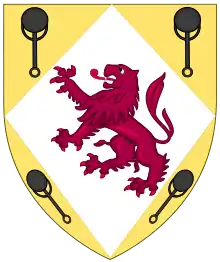
- Juan de Tapia, guerrilla fighter.
- César Arconada, writer and journalist born in Palacios del Alcor.
- Marcelino García Velasco, poet and academian of the Institución Tello Téllez de Meneses born in the capital of Palencia, but spent his childhood in Astudillo.
- Carlos Bustillo, journalist.
- Oscar Husillos, athlete.
References
- Municipal Register of Spain 2018. National Statistics Institute.
- , Oxford Reference – Titus Statilius Taurus
- , Opúsculo Sobre la Historia de la Villa de Astudillo, por Maximiliano Castrillo Martínez
- , Memorial literario, instructivo y curioso de la Corte de Madrid – Imprenta Real, 1785
- , Latinlexicon.org – Paradigm of Statilius (noun)
- , Latinlexicon.org – Definition of Statilius
- , Opúsculo Sobre la Historia de la Villa de Astudillo, por Maximiliano Castrillo Martínez
- , Castillos del Olvido – Castillo de Astudillo.
- , Castillos de Palencia – Castillo de Astudillo.
- , Palencia Turismo – Astudillo.
- , Castillos del Olvido – Muralla de Astudillo.
- , Astudillo.es – Historia.
- , Archives Portal Europe – Copia imitativa de un privilegio rodado (1152, diciembre, 13. León) por el que Alfonso VII concede fuero a las Nueve Villas (Amusco, Amayuelas de Arriba, Amayuelas de Abajo, Villaonella, Piña, Támara, Forombrada, Alba y San Esteban), y las hace donación de un monte sito entre Valdespina, Villamediana, Valdesalce y Espinosa; y del monte de Astudillo y Palacios, todos lugares de Palencia.
- , Palencia Turismo – Astudillo.
Bibliography
- Castrillo Martínez, Maximiliano (1877). Opusculo Sobre la Historia de la Villa de Astudillo (Booklet on the history of the Villa de Astudillo) (in Spanish). Editorial Maxtor.España. ISBN 84-95636-04-2.
auto